
Australian art is a broad spectrum of art created in or about Australia, or by Australians overseas, spanning from prehistoric times to the present day. The art forms include, but are not limited to, Aboriginal, Colonial, Landscape, Atelier, and Contemporary art.
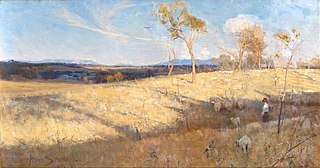
The Heidelberg School was an Australian art movement of the late 19th century. It has been described as Australian impressionism.
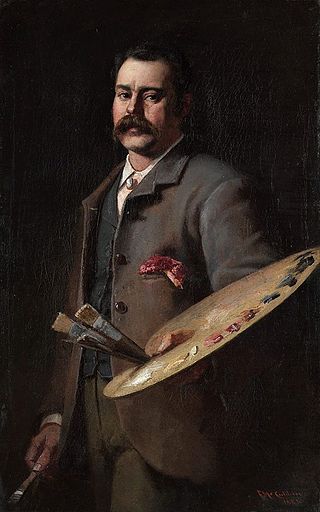
Frederick McCubbin was an Australian artist, art teacher and prominent member of the Heidelberg School art movement, also known as Australian impressionism.
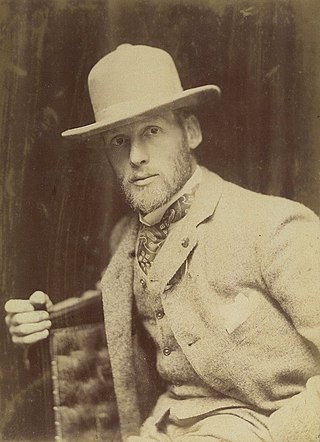
Thomas William Roberts was an English-born Australian artist and a key member of the Heidelberg School art movement, also known as Australian impressionism.

Sir Arthur Ernest Streeton was an Australian landscape painter and a leading member of the Heidelberg School, also known as Australian Impressionism.

Clara Southern was an Australian artist associated with the Heidelberg School, also known as Australian Impressionism. She was active between the years 1883 and her death in 1940. Physically, Southern was tall with reddish fair hair, and was nicknamed 'Panther' because of her lithe beauty.

The Box Hill artists' camp was a site in Box Hill, Victoria, Australia favoured by a group of plein air painters in the mid to late 1880s who later became associated with the Heidelberg School art movement, named after Heidelberg, the site of another one of their camps.

Albert Ernest Newbury was an Australian artist who was associated with the Australian tonalist movement.

Walter Herbert Withers was an English-born Australian landscape artist and a member of the Heidelberg School of Australian impressionists.

The Geelong Art Gallery, currently known as Geelong Gallery, is a major regional gallery in the city of Geelong in Victoria, Australia. The gallery has over 6,000 works of art in its collection. The Gallery forms Geelong's Cultural Precinct with the adjacent Geelong Library and Heritage Centre, Geelong Arts Centre, and the Geelong Courthouse.
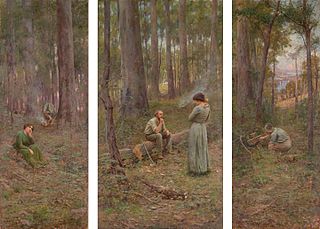
The Pioneer is a 1904 painting by Australian artist Frederick McCubbin. The painting is a triptych; the three panels tell a story of a free selector and his family making a life in the Australian bush. It is widely considered one of the masterpieces of Australian art.

Down on His Luck is an 1889 painting by the Australian artist Frederick McCubbin. It depicts a disheartened swagman, sitting by a campfire in the bush and sadly brooding over his misfortune. According to an 1889 review, "The face tells of hardships, keen and blighting in their influence, but there is a nonchalant and slightly cynical expression, which proclaims the absence of all self-pity ... McCubbin's picture is thoroughly Australian in spirit." The surrounding bush is painted in subdued tones, reflecting his somber and contemplative mood.

Violet Helen Evangeline Teague was an Australian artist, noted for her painting and printmaking.

James Peter Quinn was an Australian portrait painter born in Melbourne.

On the wallaby track is a 1896 painting by the Australian artist Frederick McCubbin. The painting depicts an itinerant family; a woman with her child on her lap and a man boiling a billy for tea. The painting's name comes from the colloquial Australian term "On the wallaby track" used to describe itinerant rural workers or "swagmen" moving from place to place for work. The work has been described as "among the best known and most popularly admired of Australian paintings".

Ada May Plante was a New Zealand-born post-impressionist artist who was one of the founding exhibitors in the Post-Impressionist Melbourne Contemporary Group. She was a member of the Melbourne Society of Women Painters and Sculptors.

Leon Pole was an Australian artist who was associated with the Heidelberg School art movement, also known as Australian Impressionism.

Louis Abrahams was a British-born Australian tobacconist, art patron, painter and etcher associated with the Heidelberg School art movement, also known as Australian Impressionism.
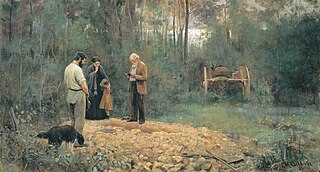
A bush burial is an 1890 painting by the Australian artist Frederick McCubbin. The painting depicts a burial attended by a small group - an older man reading from a book, a younger man with a dog, and a woman and child. The relationships between the figures is unclear and its ambiguity and sentimental nature has seen the work described as a frontier example of the Victorian-era problem pictures. From the time the painting was shown at the Victorian Artists Society Winter Exhibition in 1890, there has been differing opinions on the story told by the work with "the critic for Table Talk magazine writ[ing] that the woman is newly widowed. In The Argus, she is the grief-stricken mother of a dead child." The Age referred to the "deceased, doubtless the wife of the grey-haired old man reading the service." The burial itself also refers to the memento mori tradition.
Like Dutch vanitas pictures of the 17th century – with their skulls and snuffed candles, and fruit and flowers past their use-by date – McCubbin is reminding the viewer of the inevitability of death. You can almost hear the words being read over the grave: “Earth to earth, ashes to ashes, dust to dust.

The letter is an 1884 painting by the Australian artist Frederick McCubbin. The painting depicts a young woman reading a letter walking in the bush alongside a stream.





















